|
Steve
Jarratt is a long-time videogames
journalist and magazine editor with 25 years experience in the
industry. Having spent the majority of that time at Future Publishing,
Steve launched a number of successful and influential magazines, some
of which are still being published to this day...
|
Out-of-Print Archive: You
spent some time
in the chemist business, so how did you get involved with the videogame
magazine industry?
Steve
Jarratt: Well I became obsessed with videogaming, first on a
friend's ZX Spectrum, and then when I bought a Commodore 64. I started
buying Zzap!64 magazine and
loved it. When they advertised a position
on the team to replace Gary Liddon, I applied thinking I might get a
chance to see the offices and get to meet the team. I was lucky enough
to be interviewed but then didn't hear anything for ages. Eventually (I
think after two other people didn't work out) I was offered the job of
staff writer. This happened just before I was made redundant from my
job at the chemical company, so it was a bit of a no brainer. I upped
sticks, left home and moved to Ludlow. I was crap at chemistry anyway.
|
OoPA: While you were at
Newsfield Publications you quickly moved from staff writer to
sub-editor on Zzap!64 before
becoming editor for Crash.
What are your recollections of working for the innovative publishing
company?
SJ: It was
the
most fun I've had in work. The place was teeming
with youngsters, all running around, working hard, but having fun and
learning as we went along. The place was a right state; floor to
ceiling with games, discs, mags, busted C64s and controllers. There
were drink cans, unemptied ashtrays, paper and gaming paraphernalia
everywhere. It was chaos, but for a young bloke who loved games, it was
brilliant. And generally the people working there were a good laugh,
too - it was a very eclectic bunch. |
|
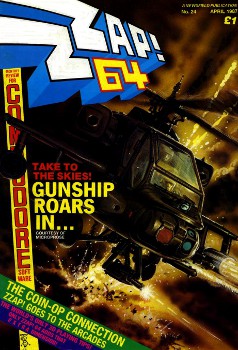 |
| OoPA: You then left
Newsfield to work for rival publishers EMAP, holding the position of
deputy editor on Commodore User
as well as contributing to the likes of C&VG
and The
One.
What prompted this move and what was it like
working for EMAP during the height of their videogaming magazine empire? |
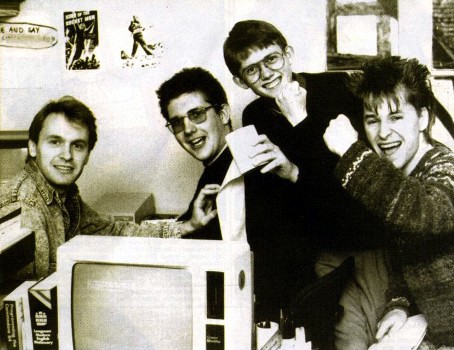
Zzap!64
staff encourage the readers to a games challenge in
issue 37 (May
1988). From left to right: Steve Jarratt,
Gordon Houghton, Paul
Glancey and
Julian Rignall
|
|
SJ: I
left with
the promise of a freelance partnership
by someone
at Newsfield, and – frankly – I got stabbed in the
back. With no real source of income, I took the job at EMAP. I never
really liked it there and had no desire to move to London so was,
stupidly, commuting from the West Midlands each day by train. That's
the kind of dumb thing you do as a kid, and I knew it couldn't last.
There were some really nice people at EMAP, but there was also a lot of
sniping and backbiting and I had no time for it. Also, I'd moved from
working on computers to a typewriter, which was like going back in time
- the production process was archaic compared to Newsfield, which also
didn't help. |
|
OoPA:
You
left EMAP to work for
Future
Publishing. What were the
reasons behind this decision?
SJ: I knew (or at
least hoped) that EMAP was only a stop-gap.
Fortunately, the late, great Graeme Kidd offered me a role on ACE,
Future's multi-format games mag. Naturally I jumped at the opportunity.
OoPA: You were then appointed
editor of new
Sega magazine called S: The Sega Mag (later
renamed Sega
Power). It
seemed quite a
bold move on Future's part to launch a dedicated Sega magazine at that
time, so what prompted that launch?
SJ: I don't really
know the precise thinking behind it, to be honest. I think Chris
Anderson had secured some sort of deal with Virgin Mastertronic which
was distributing the Master System. Initial sales were very poor but it
gradually grew and then took off when the Mega Drive arrived.
|
OoPA: From
launching a magazine that was arguably ahead of its time you then went
on to launch Commodore Format,
a magazine dedicated to the 8-bit
Commodore 64, and which many thought was behind the times.
Why
would Future launch a magazine dedicated to a computer that was thought
to be in its twilight years?
SJ: I guess someone saw that the C64 was still shifting units, still
selling games and was worth the investment. I'm pretty sure over the
course of its lifetime, CF made a stack of cash for Future, as we
enjoyed decent sales and pretty steady advertising. I'm still very
proud of the quality of the mag, and the ideas and level of work that
went in to it.
OoPA:
With an editorial team of former Zzap!64 staff, was there ever any rivalry between the two magazines?
SJ:
Yeah, of
course. It didn't
help that Zzap! kept stealing
my ideas and even the layout of some of
the pages. You always want to outsell your rival and we managed it from
a standing start really early on.
|
OoPA:
Presumably predicting demand for the upcoming SNES, Total! was launched
late 1991 with yourself as Editor. As with S,
this was the
first UK magazine dedicated to the Nintendo range of consoles. Was this
another case of being ahead of the predicted increase of gamers for the
consoles?
SJ: Again,
these
decisions weren't being made by me but by Chris Anderson who owned the
company, and the publishers in charge of the individual mags (in this
case a guy called Steve Carey). I was just lucky enough to be along for
the ride!
But I think at this stage Future recognised that games mags was going
to be a huge market. It was already big and growing every year
– so they were just looking for any inroad to a new segment
of the market. At its peak, Future had at least one mag for every games
machine out there. |
|
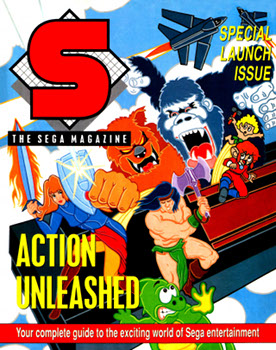 |
OoPA:
Working with staff writer
Andy Dyer,
who was also with you on Commodore
Format, you seemed to have a
lot of
fun producing Total! There
certainly was an air of humour throughout
the magazine with witty use of caricatures of the reviewers. Was that
the case in reality?
SJ: Yeah, I
always
enjoyed working with Andy and for the most part we
got on really well. I was sad to lose him to Mega in the end.
|
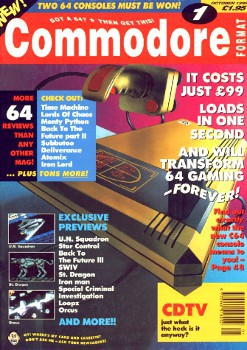 |
|
OoPA:
It has been stated by a former Future journalist that the content in Total! – as with Mega the
following year – was
written by freelance contributors with editorial staff taking credit
for the work. What are your thoughts on this subject?
SJ: I'm not
sure
about Mega,
but in the case
of Total!,
yes that was
the case. However, I think the term 'taking credit' makes it sound
underhand and sinister, when it was simply a way to populate the mag
with enough content. There's no way me and Andy could have written
everything in the time available, so we did freelance out a few reviews
and put our names to them. It was the style of the mag to have these
cartoon reviewers, so we did paint ourselves into a corner with the
original concept. It was probably naive of us at the time, but I don't
see how it's much worse than biographies being ghost-written by real
authors; as long as the reviews were fair and accurate I didn't see how
it was hurting anyone. And the writers never seemed to have a problem
with it, certainly not at the time. They were happy enough being paid. |
OoPA:
From Total!
– a
magazine
that didn't take itself too seriously – you went on to helm
the launch of Edge
in
September 1993. What prompted the launch of Edge,
considering that Future sold ACE – a similar style of magazine – a few years previously and were also publishing GamesMaster?
SJ: When ACE
was sold to
EMAP, the company had to sign a
non-competitive agreement which lasted for, I think, five years. The
moment that was up, Future wanted another multi-format games mag. By
this time I was getting older and didn't want to do kids mags any more,
and I also felt like videogaming was coming of age, with the advent of
CD-ROM, 32-bit processors, lots of 3D polygonal games and so on.
|
OoPA: Edge
was – and still
is in
many ways – known for its editorial stance and anonymous
writing style. There was one instance in particular that many readers
remember when issue one gave Gunstar
Heroes – now
generally
considered to be a Mega Drive classic – an overall rating of
6 out of 10. Was it always the plan to display a bit of harshness when
reviewing and did the anonymity of the writer contribute to the
harshness in any way?
SJ: I
suppose Edge
was the antithesis of the very character-driven
games mags I'd done, so instead of everything being written from a
particular person's perspective, I wanted it to be from 'Edge'.
|
|
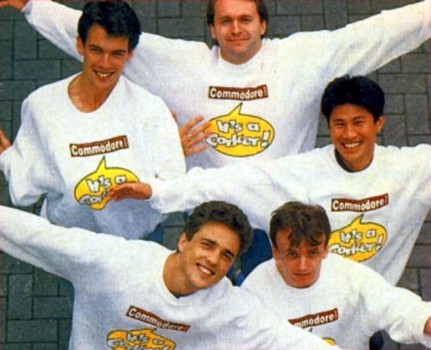
Commodore
Format
launch issue
staff.
Front: Trevor Gilham, Sean
Masterson
Back: Andy Dyer, Steve Jarratt and Lam Tang
|
The
idea being that we'd all play the games and it was a general view
– after all, if you give the wrong reviewer the wrong game,
you can get very biased opinions. However, I never meant for the mag to
start believing its own hype and evolve [into] this weird hive-mind
approach. I wanted the tone to be sort of adult and knowledgeable, but
still witty and entertaining. At various times, Edge
has been almost
unreadably pretentious. I think its current incarnation is much better
– although I haven't really read a games mag for years. |
|
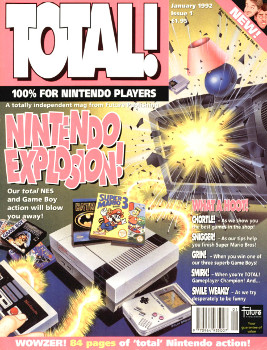 |
|
OoPA: Edge was the fourth launch magazine
that you had helmed as editor
and was now becoming your forte. Was there any added pressure and
expectations being the launch editor of a magazine?
SJ:
The
only
pressure I felt was to do something original, fresh – and
better than the previous mag. I was still learning my craft and making
mistakes.
OoPA: OoPA: During the summer
of 1994, you
became editor of Amiga Format,
one of the few times you took over as
editor from someone else. What was it like to take over as editor with
a successful magazine rather than launch one?
SJ:
Fine. No
launch hassle; no recruitment worries; a stable, existing readership...
the only thing is you need to be careful not to throw away what the
previous incumbent has achieved when trying to bring in your own ideas.
If I'm honest, I think Amiga Format probably suffered under my tenure,
because I just wasn't that big an Amiga fan. You really need to love
the subject matter to be a magazine editor, otherwise you're in the
wrong role - and probably just going through the motions. |
OoPA: There was a huge amount of
anticipation for the officially
endorsed Playstation publication with Future eventually obtaining the
rights to launch the Official
Playstation Magazine in
October 1995. As
launch editor, what are your recollections of the events surrounding
the phenomenally successful launch?
SJ: Well it
was a long time ago. I remember being pretty pleased with the design
and the structure of the mag, and some of the nice ideas we put in it,
but I think by then I'd just had enough of editing games mags.
Certainly by issue six or seven I was ready to jump ship and let
someone else take over. Of course it was exciting to be at the start of
a new generation of gaming, but it's surprising how quickly the novelty
wears off and you find yourself just editing another games mag.
|
OoPA: T3 (standing for Tomorrow's
Technology Today) was launched in the autumn of 1997 and was a slight
departure for someone who had been actively involved with videogaming
magazines for the past ten years.
SJ:
Ah - [as previously mentioned]! Three things: I was bored of doing
games mags as they're largely pretty much the
same each time – plus I'd been doing them for ages. I was
also getting too old; my pop culture references were out of date and I
didn't speak kiddie lingo any more. And I'd also been getting more and
more into computing, technology and home entertainment, so this was a
good move for me. It was a 'proper' adult magazine, so I could stretch
my editorial muscles as it were, beyond writing endless previews and
reviews.
|
OoPA: You then became Senior
Editor
and Group Senior Editor during the
intervening years. What were your responsibilities and how did these
new roles differ from your previous positions?
SJ: The idea was for me to help less experienced editors by passing on
some of the stuff I'd learned. At one point I had about 22 mags in my
portfolio, and was doing covers, redesigns, mentoring, that kind of
stuff. And I was also just available for an editor to speak to, get
some ideas, work through problems, help with staff issues and so on.
OoPA: After 20 years in the industry, you won the Games Media Legend
award at the 2008 Games Media Awards. How did it feel to win such an
award?
SJ: It was very nice to be recognised for the work I'd done. I'd been
pretty anonymous in the industry really; I never put myself about like
some of the journos, so it was a bit of a surprise that anyone even
knew what I'd been doing! |
|
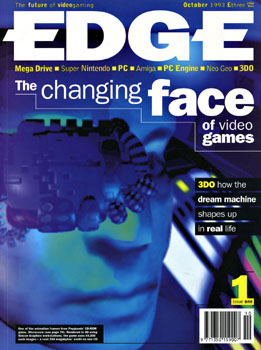 |
OoPA: Following a downscale in
staff at
Future, you decided to leave in October 2011. Having spent over 23
years at the company, it must have been a tough decision.
SJ: Well I'd
been enjoying the Group Senior role less and less, as I
felt I had no real direction. So I asked to take on an editorship again
– I kind of demoted myself I suppose. And although it was
only supposed to be temporary, I was still there two years later when
the axe fell. My role was made redundant and rather than reapply for my
old job – probably on half the wages – I figured
Future had had enough of me and so I just took voluntary redundancy.
OoPA:
You’re currently working freelance, but are you still
involved with videogame magazines at all? What are your
thoughts on the current crop of videogame magazines?
SJ: I'm no
longer directly involved with game journalism (expect a few
iOS reviews) and, much like the rest of the population, I don't read
mags any more! But I do go to websites every day: mainly Eurogamer and
CVG, plus the occasional flirt with a few other sites and Zero
Punctuation. However I do find a lot of the writing a bit like they're
trying too hard to be edgy and culturally relevant. The number of times
I skip past the first three paragraphs so the writer can get their
creative writing wankfest out of the way and start actually talking
about the game...
|
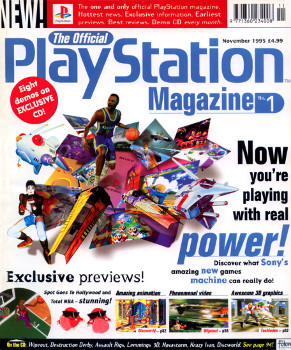 |
|
OoPA: Edge is
still highly regarded as much today as it was when it was
launched and doesn't appear to be doing as badly as the other
magazines. Do you still keep an eye on
the current issues of Edge and,
if so, how do you compare it to 1993/94 Edge?
Why do you think it has
remained so successful?
SJ: Well
it's still losing readers, but at a slower rate than its
competition – and it's possible some of them are now reading
the iPad edition, which is very good. I think the mag delivers real
quality editorial, and 'proper' journalism. The team goes
out, they do
interviews, they break exclusives – it's still content worth
paying for. It still fulfils a particular need
and does it very well.
But I'm afraid the last time I read the mag was when I was at Future
which is probably about 18 months ago, so I wouldn't want to make any
real comparisons. (Although I'm pretty confident the current issues are
far, far better than the ones I did!) |
OoPA: Looking back at the many
magazines in
the day, what were your favourites and why?
SJ: Of the
ones I edited, I think Commodore
Format is my proudest
achievement. I never really liked a lot of the competition to be
honest, so never read them!
|
OoPA:
What do you think about videogaming magazine preservation projects like
Out-of-Print Archive?
SJ: It's
good that
all that
hard work, creativity and ingenuity doesn't just get forgotten. And
they might be useful for people interested in media and games
journalism or gaming nostalgia.
OoPA: Having spent 25 years in
the industry what would you say are your
fondest memories and biggest achievements? How would you like to be
remembered?
SJ: My
fondest memories are working on Zzap!64.
Biggest achievement I
suppose will be Edge,
even
though I only edited seven or eight issues.
And I'd really like to be remembered for winning the triple-roll-over
Euromillions and spunking all the cash on a house like Tony Stark's and
a collection of jets and supercars. |
|
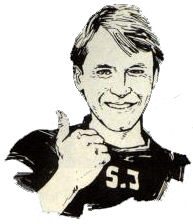 |
All the intellectual property rights related to the works presented on this site belong to their respective owners.
This site is strictly created for the purpose of preservation and education.
Follow us on Mastodon to get the latest updates as they go live as well as daily magazine articles:
 |
|
|